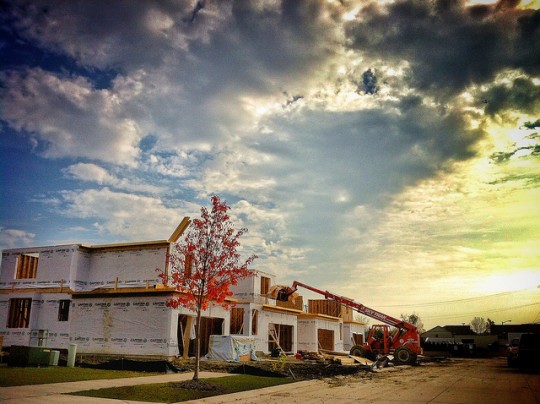Freddie Mac’s quarterly refinance analysis for the fourth quarter of 2013 shows borrowers continuing to take advantage of historically low mortgage rates to reduce their monthly mortgage payment and shorten their loan terms. According to the report, borrowers who refinanced in 2013 will save on net approximately $21 billion in interest over the next year. Frank Nothaft, Freddie Mac’s vice president and chief economist, said the refinance boom began to wind down as the pool of potential borrowers declined and mortgage rates increased during the second half of the year. According to Nothaft, the refinance share of total mortgage activity will fall further this year, as refinance demand drops and the emerging purchase market consumes a bigger piece of the pie. Also in the report, the average interest rate reduction in the fourth quarter was about 1.5 percentage points. On a $200,000 loan, that’s a $3,000 savings over the next 12 months. More here.
Archive for February 2014
Economists Forecast Solid Year For Housing
Following a year of significant improvement in the housing market, four prominent economists are forecasting a solid 2014, according to a yearly survey from RealtyTrac. Mark Zandi, chief economist at Moody’s Analytics, believes this year should be a good one for the economy, as long as government gridlock doesn’t interfere with the progress. Zandi feels that if policymakers do no harm in 2014, the economy should do well and home prices should rise about 5 percent. The National Association of Realtors’ Lawrence Yun also expressed concern over federal policies, warning that regulations focused on lowering default risk may, in fact, restrict access to credit and impede the mortgage market. On the other hand, Chris Thornberg, principal at Beacon Economics, sees continued improvement in the housing market’s future. According to Thornberg, new home sales should be up this year and – though existing-home sales will remain around the same level as last year – there will be less investor activity and more retail buyers. Other economists cautioned that there is still room for improvement in the economy and housing market. Jed Kolko, chief economist at Trulia, is concerned that, while prices and sales volumes are now near normal levels, a shaky labor market means fewer young adults are moving out on their own and forming households. More here.
Average Mortgage Rate Continues To Fall
According to the Mortgage Bankers Association’s Weekly Applications Survey, the average contract interest rate declined last week for all loan products in the survey, including 30-year fixed-rate mortgages with both jumbo and conforming balances, 15-year mortgages, and those backed by the FHA. That marks the fourth consecutive week average mortgage rates have fallen. Despite the rate drops, however, overall demand for mortgage-loan applications was relatively flat, increasing just 0.4 percent. The Refinance Index was up 3 percent over the previous week while the seasonally adjusted Purchase Index – a leading indicator of home sales – fell 4 percent. The MBA’s survey covers more than 75 percent of U.S. retail residential mortgage applications and has been conducted weekly since 1990. More here.
Older Buyers Boost Builders’ Expectations
Recently surveyed builders expressed surging confidence in the market for newly built single-family homes among buyers age 55 and up. According to the results of the latest National Association of Home Builders 55+ Housing Market Index – which measures builders’ confidence on a scale where any number above 50 indicates more builders view conditions as good than poor – confidence in the market for single-family homes increased 20 points year-over-year to a level of 48, the highest fourth-quarter reading since the NAHB began tracking the data in 2008. Robert Karen, chairman of the NAHB’s 50+ Housing Council, said they are seeing continued improvement in the 55+ housing market because consumers have gained confidence in the economy and are able to sell their current homes and move into a new home or condo that fits the lifestyle they desire. Karen expects this optimism from builders and developers to carry through 2014. All individual components of the single-family HMI showed significant improvement, with confidence in present sales levels climbing 26 points from one year ago. More here.
The Homeownership Rate Finds A New Normal
The Census Bureau’s Housing Vacancy Survey tracks the homeownership and vacancy rates for owner-occupied and rental housing across the country. Since they began tracking this data in 1965, the results have shown a steady rise in the number of Americans who own their own home. From an early low of 62.9 percent, the homeownership rate climbed to a high of 65.8 percent in the 1980s before settling into a roughly 10-year period where it hovered around 64 percent. Then, in the mid-1990s, homeownership levels began to rise again, setting a new high in 2004 at 69.2 percent. Since falling during the financial crisis and recent recession, the homeownership rate has, once again, settled. The latest data shows the rate has plateaued at 65 percent and has remained virtually the same since the 2nd quarter of 2013. If the homeownership rate stays at 65 percent, it would be higher than the historical norm but still below the highs of the housing bubble. More here.
Confidence In Economy Hits Five Year High
Americans grew more confident in the economy in 2013, according to recently released data from Gallup. Though their perception of economic conditions and the future direction of the economy experienced some ups-and-downs throughout the year, Americans were more optimistic than in years past, with gains seen across several key indicators. Gallup’s Job Creation Index, for example, gained two points from its year-before level, while economic confidence rose five points and average daily spending increased to $88, a $16 improvement over 2012. Overall, Americans were more confident in the economy than in the previous five years, which is a positive sign that the economy is recovering from the most recent recession. Still, Gallup warns that it is unclear how strong the economic recovery is due in part to the support its received from the Federal Reserve over the past two years. This year, the Fed will begin winding down some of the economic stimulus that has been keeping interest rates at historic lows and helping boost the economy and housing market. Though this has the potential to drive rates up, the Fed has indicated that it will keep short-term rates low until unemployment drops or inflation becomes a concern. More here.






